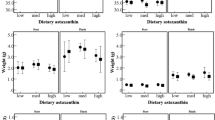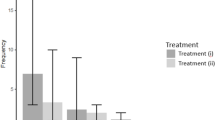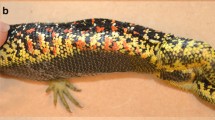Abstract
Several populations of threespine stickleback (Gasterosteus aculeatus) on the Pacific Coast of North America remain drab during courtship and become melanic during parental care rather than adopt the species typical red signal. Male signal redness is an honest signal of male physiological condition. Here, I test the prediction that reflectance characteristics of drab males also honestly indicate male condition. I located, observed and captured nesting stickleback from Brannen Lake, British Columbia, Canada. I measured reflectance characteristics of each male’s signal right after capture and later measured its wet weight and total length to calculate Fulton’s condition index, K. Males in better condition, higher K, had lower total reflectance (i.e. were darker) than males in poorer condition. The principals underlying honest signaling appear to be operating despite the possession of a novel nuptial signal in Brannen Lake stickleback.



Similar content being viewed by others
References
Aerends RJ, Mancera JM, Moñoz JL, Wendelaar Bonga SE, Flik G (1999) The stress response of the gilthead sea bream (Sparus aurata L.) to air exposure and confinement. J Endocrinol 163:149–157
Aerends RJ, Rotllant J, Metz JR, Mancera JM, Wendlaar Bonga SE, Flik G (2000) α-MSH acetylation in the pituitary of the sea bream (Sparus aurata L.) in response to different backgrounds, confinement and air exposure. J Endocrinol 166:427–435
Anderson PJB, Rogers QR, Morris JG (2002) Cats require more dietary phenylalanine or tyrosine for melanin deposition in hair than for maximal growth. J Nutr 132:2037–2042
Andersson M (1994) Sexual selection. Princeton University Press, Princeton
Badyaev AV, Hill GE (2000) Evolution of sexual dichromatism: contribution of carotenoid- versus melanin-based plumage coloration. Biol J Linn Soc 69:153–172
Bakker TCM, Mundwiler B (1994) Female mate choice and male red coloration in a natural three-spined stickleback (Gasterosteus aculeatus) population. Behav Ecol 5:74–80
Bakker TCM, Mazzi D, Kraak SBM (2006) Broods of attractive three-spined stickleback males require greater paternal care. J Fish Biol 69:1164–1177
Boughman JW (2001) Divergent sexual selection enhances reproductive isolation in sticklebacks. Nature 411:944–948
Candolin U (2000) Male-male competition insures honest signaling of male parental ability in three-spined stickleback (Gasterosteus aculeatus). Behav Ecol Sociobiol 49:57–61
Chelleppa S, Huntingford FA (1989) Depletion of energy reserves during reproductive aggression in male three-spined stickleback, Gasterosteus aculeatus. L J Fish Biol 35:315–316
Chelleppa S, Huntingford FA, Strang RHC, Thomson RY (1995) Condition factor and hepatosomatic index as estimates of energy status in male three-spined stickleback. J Fish Biol 47:775–787
Cuthill IC, Bennett ATD, Partridge JC, Maier EJ (1999) Plumage reflectance and the objective assessment of avian sexual dichromatism. Am Nat 153:183–200
Czeczuga B (1980) Carotenoids in fish XXVI. Pungitius punitius (L.) and Gasterosteus aculeatus L. (Gasterosteidae). Hydrobiol 74:7–10
Doucet SM, Mennill DJ, Montgomerie R, Boag PT, Ratcliffe LM (2005) Achromatic plumage reflectance predicts reproductive success in male black-capped chickadees. Behav Ecol 16:218–222
Endler JA (1990) On the measurement and classification of colour in studies of animal colour patterns. Biol J Linn Soc 41:315–352
FitzGerald GJ (1992) Fillial cannibalism in fishes, why do parents eat their offspring? Trends Ecol Evol 7:7–10
Fujii R (2000) The regulation of motile activity in fish chromatophores. Pigment Cell Res 13:300–319
Fuller RC (2002) Lighting environment predicts relative abundance of male colour morphs in bluefin killifish (Lucania goodie) populations. Proc Roy Soc Lond B 269:1457–1465
Getty T (2002) Signaling health versus parasites. Am Nat 159:363–371
Getty T (2006) Sexually selected signals are not similar to sports handicaps. Trends Ecol Evol 21:83–88
Gillooly JF, Bayliss JR (1999) Reproductive success and the energetic cost of parental care in male smallmouth bass. J Fish Biol 54:573–584
Haffter P, Odenthal J, Mullins MC, Lin S, Farrell MJ, Vogelsang E, Haas F, Brand M, van Eeden FJM, Furutani Seiki M, Granato M, Hammerschmidt M, Heisenberg CP, Jiang YJ, Kane DK, Kelsh RN, Hopkins N, NussleinVolhard C (1996) Mutations affecting pigmentation and shape of the adult zebrafish. Dev Genes Evol 206:260–276
Hill GE (1996) Redness as a measure of the production cost of ornamental coloration. Ethol Ecol Evol 8:157–175
Hillstrom L (1995) Body mass reduction during reproduction in the pied flycatcher, Ficedula hypoleuca: physiological stress or adaptation for lowered costs of locomotion? Funct Ecol 9:807–817
Hoelzer GA (1989) The good parent process of sexual selection. Anim Behav 38:1067–1078
Horak P, Jenni-Eirmann S, Ots I (1999) Do great tits (Parus major) starve to reproduce? Oecologia 119:293–299
Kawauchi H, Baker BI (2004) Melanin concentrating hormone signaling systems in fish. Peptides 25:1577–1584
Kondolph M, Okudah N (2002) Mate availability influences filial cannibalism in fish with parental care. Anim Behav 63:227–233
Laurin AY, Scott RJ (2009) Effect of handling on male threespine stickleback mating signals. Environ Biol Fish 85:109–115
Lissaker M, Kvarnemo C (2006) Ventilation or nest defense—parental care trade-offs in a fish with male parental care. Behav Ecol Sociobiol 60:864–873
Mackereth RW, Noakes DLG, Ridgway MS (1999) Size-based variation in somatic energy reserves and parental expenditure by male smallmouth bass, Micropterus dolomiue. Environ Biol Fish 56:263–275
Marconato A, Bisazza A, Fabris M (1993) The cost of parental care and egg cannibalism in the river bullhead, Cottus gobio, L. (Pisces, Cottidae). Behav Ecol Sociobiol 32:229–237
McGraw KJ (2003) Melanins, metals, and mate quality. Oikos 102:402–406
McLennan DA, McPhail JD (1989) Experimental investigations of the evolutionary significance of sexually dimorphic nuptial coloration in Gasterosteus aculeatus (L.)—temporal changes in the structure of the male mosaic signal. Can J Zool 67:1767–1777
McPhail JD (1969) Predation and the evolution of a stickleback (Gasterosteus). J Fish Res Board Can 26:3183–3208
Milinski M, Bakker TCM (1990) Female stickleback use male coloration in mate choice and hence avoid parasitized males. Nature 344:330–333
Moller AP (2000) Male parental care, female reproductive success and extrapair paternity. Behav Ecol 11:161–168
Moller AP, Jenions MD (2001) How important are direct fitness benefits of sexual selection? Naturwissenschaften 88:401–415
Neff BD, Cargnelli LM (2004) Relationships between condition factors, parasite load and paternity in bluegill sunfish, Lepomis macrochirus. Eviron Biol Fish 71:297–304
Neff BD, Pitcher TE (2005) Genetic quality and sexual selection: an integrated framework for good genes and compatible genes. Mol Ecol 14:19–38
Niecke M, Rothlaender S, Roulin A (2003) Why do melanin ornaments signal individual quality? Insights from metal element analysis of barn owl feathers. Oecologia 137:153–158
Pissios P, Maratos-Flier E (2003) Melanin-concentrating hormone: from fish skin to skinny mammals. Trends Endocrinol Metab 14:243–248
Poston JP, Hasselquist D, Stewart IRK, Westneat DF (2005) Dietary amino acids influence plumage traits and immune responses of male house sparrows, Passer domesticus, but not as expected. Anim Behav 70:1171–1181
Préault M, Chastel O, Cézilly F, Faivre B (2005) Male bill colour and age are associated with parental abilities and breeding performance in blackbirds. Behav Ecol Sociobiol 58:497–505
Price T, Schluter D, Heckman NE (1993) Sexual selection when the female directly benefits. Biol J Linn Soc 48:187–211
Qu D, Ludwig DS, Gammeltoft S, Piper M, Pelleymounter MA, Cullen MJ, Mathes WF, Przypek J, Kanarek R, Maratos-Flier E (1996) A role for melanin-concentrating hormone in the central regulation of feeding behaviour. Nature 380:243–247
Reimchen TE (1989) Loss of nuptial color in threespine sticklebacks (Gasterosteus aculeatus). Evolution 43:450–460
Ridgway MS, McPhail JD (1984) Ecology and evolution of sympatric sticklebacks (Gasterosteus): mate choice and reproductive isolation in the Enos lake species pair. Can J Zool 62:1813–1818
Robin JP, Fayolle C, Decrock F, Thil MA, Cote SD, Bernard S, Groscolas R (2001) Restoration of body mass in King Penguins after egg abandonment at a critical energy depletion stage: early vs. late breeders. J Avian Biol 32:303–310
Rowe MP, Baube CL, Phillips JB (2006) Trying to see red through stickleback photoreceptors: functional substitution of receptor sensitivities. Ethology 112:218–229
Scott RJ (2001) Sensory drive and nuptial colour loss in threespine stickleback. J Fish Biol 59:1520–1528
Scott RJ (2004) Assortative mating between adjacent populations of threespine stickleback (Gasterosteus aculeatus). Ecol Freshw Fish 13:1–7
Scott RJ, Foster SA (2000) Field data do not support a textbook example of convergent character displacement. Proc Roy Soc Lond B 267:607–612
Scott RJ, Ridgway MS, Noakes DLG (1997) The nest range of small mouth bass (Micropterus dolomiue): parental care after swim-up. Can J Zool 75:2058–2062
Seifferman L, Hill GE (2003) Structural and melanin coloration indicate parental effort and reproductive success in male eastern bluebirds. Behav Ecol 14:855–861
Shi Y (2004) Beyond skin color: emerging roles of melanin-concentrating hormone in energy homeostatsis and other physiological functions. Peptides 25:1605–1611
Smit N, Vicanova J, Cramers P, Vrolijk H, Pavel S (2003) The combined effects of extracts containing carotenoids and vitamins E and C on growth and pigmentation of cultured human melanocytes. Skin Pharmacol Physiol 17:238–245
Smith C, Wootton RJ (1999) Parental energy expenditure of the male three-spined stickleback. J Fish Biol 54:1132–1136
Stoehr AM (2006) Costly melanin ornaments: the importance of taxon. Funct Ecol 20:276–281
Takahashi A, Tsuchiya K, Yamanome T, Amano M, Yasuda A, Yamamori K, Kawauchi H (2004) Possible involvement of melanin-concentrating hormone in food intake in a teleost fish, barfin flounder. Peptides 25:1613–1622
Takahashi A, Kosugi T, Kobayashi Y, Yamanome T, Schioth HB, Kawauchi H (2007) The melanin-concentrating hormone receptor 2 (MCH-R2) mediates the effect of MCH to control body color for background adaptation in the barfin flounder. Gen Comp Endocrinol 151:210–219
van der Salm AL, Pavlidis M, Flik G, Wendelaar Bonga SE (2004) Differential release of α-mepanophore stimulating hormone isoforms by the pituitary gland of red progy, Pagrus pagrus. Gen Comp Endocrinol 135:126–133
van Nieuwpoort F, Smit NPM, Kolb R, van der Meulen H, Koerten H, Pavel S (2004) Tyrosine-induced melanogenesis shows differences in morphologic and melanogenic preferences of melanosomes from light to dark skin types. J Invest Dermatol 122:1251–1255
Wedekind C, Meyer P, Frischknech M, Niggli UA, Pfander H (1998) Different carotenoids and potential information of red coloration of male three-spined stickleback. J Chem Ecol 24:787–801
Williamson SJ, Cummins HZ (1983) Light and color in nature and art. Wiley, New York
Wooton RJ (1998) The ecology of teleost fish, 2nd edn. Kluwer, Dordrecht
Yamanome T, Amano M, Takahashi A (2005) White background reduces the occurrence of staining, activates melanin-concentrating hormone and promotes somatic growth in barfin flounder. Aquacult 244:323–329
Acknowledgements
A. Laurin and A. Tzarougian provided assistance in the field. Funding was provided by the Natural Science and Engineering Research Council of Canada and by the Faculty of Science, The University of Western Ontario, London, Ontario, Canada.
Author information
Authors and Affiliations
Corresponding author
Rights and permissions
About this article
Cite this article
Scott, R.J. Reflectance characteristics are correlated with male condition in a population of threespine stickleback (Gasterosteus aculeatus) that has lost the species typical nuptial signal. Environ Biol Fish 91, 287–294 (2011). https://doi.org/10.1007/s10641-011-9780-8
Received:
Accepted:
Published:
Issue Date:
DOI: https://doi.org/10.1007/s10641-011-9780-8




